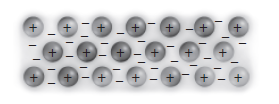
Concept explainers
Interpretation:
The description which is supported by the model shown is to be determined:

Concept introduction:
Physical characteristic of metals is as follows:
- They are good conductors of heat and electricity.
- They have a shiny surface.
- Malleable and ductile.
- They are found as solid in room temperature except for mercury (it is liquid at RT).
Answer to Problem 1STP
The model supported description B. Metals are excellent conductors of heat and electricity.
Explanation of Solution
Reason for correct option: The figure given in the question explained that the metals are excellent conductors of heat and electricity. Metals exist in a metallic solid. The figure shows that cations are encompassed by a sea of delocalized electrons. Metals conduct heat and electricity very well because the ions are close packing and the delocalized electrons conduct kinetic energy. Therefore, option B is correct.
Reason for incorrect option: A. Metals are shiny, reflective substances. It is a characteristic of the metal. But the figure does not explain why this property exists. So, option A, does not verify the figure.
C. Ionic compounds are malleable compounds. This statement is not correct because ionic solids disperse when an outside force is applied to them. The figure shows that cations encompassed by a sea of electrons. That means the figure apparently introducing metallic solids, not ionic solids. Therefore, option C, does not support the figure.
D. Ionic compounds are good conductors of electricity. This statement is not correct because it specified that the ionic compound conducts electricity only in the melted or dissolved state. The given figure shows that cations surrounded by a sea of electrons. That means the figure clearly referring metallic solids not ionic solids. Therefore, option C, does not support the figure.
Chapter 7 Solutions
Chemistry: Matter and Change
Additional Science Textbook Solutions
Introductory Chemistry (5th Edition) (Standalone Book)
Chemistry: A Molecular Approach (4th Edition)
CHEMISTRY-TEXT
General Chemistry: Principles and Modern Applications (11th Edition)
Chemistry: The Central Science (14th Edition)
Chemistry: A Molecular Approach
 ChemistryChemistryISBN:9781305957404Author:Steven S. Zumdahl, Susan A. Zumdahl, Donald J. DeCostePublisher:Cengage Learning
ChemistryChemistryISBN:9781305957404Author:Steven S. Zumdahl, Susan A. Zumdahl, Donald J. DeCostePublisher:Cengage Learning ChemistryChemistryISBN:9781259911156Author:Raymond Chang Dr., Jason Overby ProfessorPublisher:McGraw-Hill Education
ChemistryChemistryISBN:9781259911156Author:Raymond Chang Dr., Jason Overby ProfessorPublisher:McGraw-Hill Education Principles of Instrumental AnalysisChemistryISBN:9781305577213Author:Douglas A. Skoog, F. James Holler, Stanley R. CrouchPublisher:Cengage Learning
Principles of Instrumental AnalysisChemistryISBN:9781305577213Author:Douglas A. Skoog, F. James Holler, Stanley R. CrouchPublisher:Cengage Learning Organic ChemistryChemistryISBN:9780078021558Author:Janice Gorzynski Smith Dr.Publisher:McGraw-Hill Education
Organic ChemistryChemistryISBN:9780078021558Author:Janice Gorzynski Smith Dr.Publisher:McGraw-Hill Education Chemistry: Principles and ReactionsChemistryISBN:9781305079373Author:William L. Masterton, Cecile N. HurleyPublisher:Cengage Learning
Chemistry: Principles and ReactionsChemistryISBN:9781305079373Author:William L. Masterton, Cecile N. HurleyPublisher:Cengage Learning Elementary Principles of Chemical Processes, Bind...ChemistryISBN:9781118431221Author:Richard M. Felder, Ronald W. Rousseau, Lisa G. BullardPublisher:WILEY
Elementary Principles of Chemical Processes, Bind...ChemistryISBN:9781118431221Author:Richard M. Felder, Ronald W. Rousseau, Lisa G. BullardPublisher:WILEY





